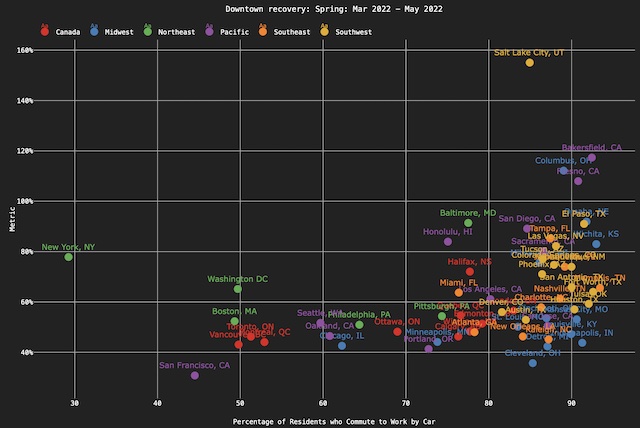
An article in Salon by anti-capitalist Chris Hedges argues that our civilization is on the verge of collapse. As evidence, he points to the 65 percent decline of the population of St. Louis since 1950.
This decline, however, only applies to the city of St. Louis, which is a political entity. The St. Louis metropolitan area, which is an economic unit, has grown by 68 percent in the same time period.
This change took place in response to changing technologies that will be familiar to Antiplanner readers. Before World War I, most downtown jobs were in factories that didn’t pay workers enough for them to afford to take mass transit to work. As a result, they crowded into dense housing within walking distance of jobs. Between 1920 and 1970, factories moved to the suburbs, worker pay increased, those workers bought cars and moved to the suburbs themselves. This was an evolutionary process, not a sign of collapse.
Downtown property owners didn’t appreciate the dispersion of jobs to the suburbs and pressured city governments to write numerous and usually futile downtown recovery plans. These plans failed to turn back the clock as downtowns instead evolved from factory and retail centers to financial service centers to entertainment centers.
Now cities and downtowns are evolving again in response to the recent pandemic. A recent report from the University of California, Berkeley, finds that only four downtowns out of the 62 largest cities in the United States and Canada have recovered 100 percent or more of their pre-COVID economic activities. The report uses cell phone tracking data to estimate the economic activity in downtowns and cities before and after the pandemic.
Three of the four downtowns that have fully recovered — Bakersfield, Fresno, and Salt Lake City — are smaller urban areas whose downtowns weren’t very large in the first place, and the fourth — Columbus — is on the border between big and large with just over a million people. The study also found that economic activity had fully recovered in just ten of the 62 central cities in the sample. With the exception of San Diego, these were also mostly smaller urban areas.

A comparison of downtown recovery with the percentage of people who commute by car. See explanatory variables to make similar charts based on other factors.
Downtown and city recovery, the paper found, were positively correlated with the percentage of people in the urban area who commuted to work by car and negative correlated with the percentage who commuted by transit. Recovery was also negatively correlated with the city’s housing density and positively correlated with the share of the city’s households who live in single-family homes.
Unfortunately, the evolutionary changes resulting from the pandemic are likely to lead to another batch of futile but expensive downtown plans. The authors of this study say “it may be time to reinvent downtown,” but the reinvention ideas they suggest may do more harm than good.
In particular, they point to a “recent policy hackathon held by Politico” that proposed “rethinking streets for transit, bikes and pedestrians; moving parking to the outskirts of downtown; and attracting diverse segments of the population to visit (both in terms of age and race/ethnicity).” These proposals, like so many previous downtown plans, would attempt to turn back the clock to a time before the automobile became ubiquitous. That would limit downtown’s market to the small share of households who are willing to do without an automobile. As the paper notes, accomplishing this would “take significant public-private collaboration,” meaning large subsidies.
Instead of subsidies and grandiose plans that aren’t going to work anyway, it would be better for cities to let downtowns evolve on their own. The best thing cities can do to promote a positive future for downtowns is to tackle the problems of crime and homelessness that are keeping many people away from downtown areas. But that’s an issue for another day.
This piece first appeared at The Antiplanner.
Randal O'Toole, the Antiplanner, is a policy analyst with nearly 50 years of experience reviewing transportation and land-use plans and the author of The Best-Laid Plans: How Government Planning Harms Your Quality of Life, Your Pocketbook, and Your Future.
Photo: David Schwen, via Wikimedia under CC 4.0 License.












